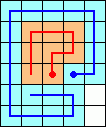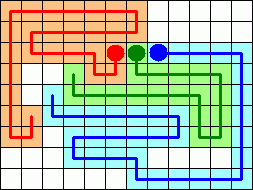

What is the shortest solution for two balls starting in vertically adjacent squares? What about other starting positions? The case of 3 balls starting in diagonally adjacent squares has a solution of length 70. Can you find it? Is there a shorter solution? Can you show that 3 balls can always be solved regardless of the starting position? Can you solve the case of 4 balls starting in diagonally adjacent squares? Do these solutions generalize to larger numbers of balls?

Claudio Baiocchi found the following 15-move solution: E-N-W-N-2E-N-W-2N-E-S-3N

Ed Pegg published this 70-move solution to the case for 3 balls starting diagonally: W-3S-4E-N-E-2S-2W-2S-2W-S-W-3S-6E-6N-S-3W-5S-3N-W-S-9E-11N-W

Clint Weaver improved this to a 49-move solution: S-W-6N-8E-S-4W-2S-E-4N-W-E-S-E-3W-4E-6N-4W

Then Jonathan Welton improved this further to a 47-move solution: S-W-6N-6E-S-5W-S-E-3N-4W-2E-S-5E-6N-4W

Bill Clagett improved this to a 23-move solution: E-2N-E-2S-2E-N-W-3E-N-W-3E-S-N-3S.

Bill Clagett also found the shortest solutions for the two ball problem starting from any two starting positions. Below is a sample of his data. If the balls start at (0,0) and (x,y), and |x|+|y|>3, then the smallest number of moves it takes to make the balls horizontal is 2|x|+2|y|+1, unless x=0 (in which case the answer is |y|+6) or |y|<2 (in which case the answer is 2|x|–2|y|+7).
starting solution positions length solution (0, 0), (0, 1) 15 ENWNEENWNNESNNN (0, 0), (0, 2) 13 EENNNWWSESWNN (0, 0), (0, 3) 12 NEENNWWSWSSS (0, 0), (0, 4) 14 NNEENNWWSWSSSS (0, 0), (1, 1) 14 ENNEESWSSENSSS (0, 0), (1, 2) 7 ENNWSNN (0, 0), (1, 3) 9 NENNWSNNN (0, 0), (1, 4) 11 NNENNWSNNNN (0, 0), (2, 0) 14 NNEEESSWNSEENN (0, 0), (2, 1) 9 NEEESWEEN (0, 0), (2, 2) 9 EENNWSNNE (0, 0), (2, 3) 11 NEENNWSNNNE (0, 0), (2, 4) 13 NNEENNWSNNNNE (0, 0), (3, 0) 14 ENNEESSSWSWNSE (0, 0), (3, 1) 11 ENEEESWEEEN (0, 0), (3, 2) 11 NENEESWEENS (0, 0), (3, 3) 13 NNENEESWEENNS (0, 0), (3, 4) 15 NNNENEESWEENNNS (0, 0), (4, 0) 15 ENNEEESSWWSWWWN (0, 0), (4, 1) 13 EENEEESWEEEEN (0, 0), (4, 2) 13 NEENEESWEENSW (0, 0), (4, 3) 15 NNEENEESWEENNSW (0, 0), (4, 4) 17 NNNEENEESWEENNNSW
If you can extend any of these results, please e-mail me. Click here to go back to Math Magic. Last updated 4/5/04.